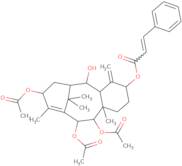
Informations sur le produit
- (2alpha,5alpha,9alpha,10beta,13alpha)-9,10,13-tris(acetyloxy)-2-hydroxytaxa-4(20),11-dien-5-yl (2E)-3-phenylprop-2-enoate
- 2-propenoic acid, 3-phenyl-, (3S,4aR,5R,6R,8S,11R,12R,12aR)-8,11,12-tris(acetyloxy)-1,2,3,4,4a,5,6,7,8,11,12,12a-dodecahydro-5-hydroxy-9,12a,13,13-tetramethyl-4-methylene-6,10-methanobenzocyclodecen-3-yl ester, (2E)-
- Taxinin NN1
Taxol is a chemotherapy drug that is used to treat cancer. It binds to the microtubules and stabilizes them, preventing the cells from dividing. Taxol also has an effect on G2-M phases of the cell cycle by inhibiting DNA synthesis. The most common side effects are hypersensitivity reactions, neurotoxicity, and peripheral neuropathy. Taxol can be recycled in humans after hydroxylation and acetylation. Taxol has a wide variety of clinical uses, including effective chemotherapy for many types of cancer and as an adjuvant treatment for ovarian cancer. It has been shown to be effective against many types of multidrug-resistant tumor cells in culture studies.
Taxol was first isolated from the bark of the Pacific Yew Tree (Taxus cuspidata) in 1962 by Dr. George Mertz at Purdue University in West Lafayette, Indiana, who was exploring methods for synthesizing complex molecules from simple ones. This led to the discovery of tax
Propriétés chimiques
Question d’ordre technique sur : 3D-FIA44022 Taxezopidine G
Si vous souhaitez demander un devis ou passer commande, veuillez plutôt ajouter les produits souhaités à votre panier, puis demander un devis ou passer commande à partir de votre panier. C'est une méthode plus rapide, plus économique, et vous pourrez bénéficier des remises disponibles ainsi que d'autres avantages





